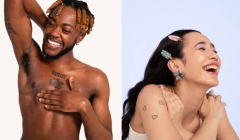
CoppaFeel brand refresh aims to reach a new generation
The charity has worked with Livity to encourage young people to check their chest

The second part of our series discusses why International Women’s day demands so much more than performative feminism.

When author and activist Sophie Walker laid out her tips to survive the ‘annual corporate calamity’ that is #InternationalWomensDay2023 she highlighted the double standards still at play in the creative industries. From failing to pay female speakers to the reminder to check your organisation’s pay gap (@PayGapApp), patience with performative feminism is running thin.
‘If you are planning to take lots of photographs of your staff posing for the annual hashtag, make sure they get to dress up like an 80s pop, band at least,” she urged. Reminding readers: “A social media slogan about appreciating all the women who slog for you doesn’t cut it. If you want to recognise the female talent in your organisation, either give them all the day off (paid). Or ask all the men in your organisation to leave early for school pick up.”
In 2023 ‘pink washing’ is still in full flow, with organisations lining up to adopt the language of feminism, whilst steadfastly remaining the status quo. Yet cynicism remains the enemy of creativity; while there are clearly challenges with performative feminism, it is equally clear that creativity can help drive genuine change.
From Saatchi & Saatchi’s ‘Cry for help’ campaign for Pregnant Then Screwed, to CPB London’s powerful ‘Double Standards’ campaign; creativity brings with it the opportunity to drive meaningful change.
Yet, do these campaigns remain the exception rather than the rule? With this question in mind we asked industry experts if its time for brands to stop simply celebrating International Women’s Day and start investing in closing the gap. Will International Women’s Day 2023 be a turning point for performative feminism?

Will International Women’s Day 2023 be a turning point for performative feminism? My feeling is no. In fact, we should stop looking for ‘turning points’ and simply get on with the work. A ‘turning point’ only works if enough people turn at once, and the drawback here is that many employers will wait to identify whether the movement is really one they need to be participating in, or if they can get by using performative gestures only.
There is no harm in marking International Women’s Day, but - much like Pride or Black History month - these awareness events ring hollow if they’re not part of meaningful, structural, year-round work. What is your brand doing every day to promote under-represented groups, celebrate their voices and understand the things that matter to them? Have you got women in leadership positions, on your boards, behind your cameras, chairing meetings and heading teams?
If not, better to ignore IWD altogether this year and spend the time you might have used to celebrate it to assess honestly how your organisation is performing when it comes to equity.
Tone-deaf brand campaigns aren’t new - and this one is not good - but focussing on the cheesiness of “embrace equity” deflects attention from the real problem. Celebrating IWD is not, in itself, a sign of progress.

International Women’s Day is still an important day to mark, but one day isn't going to change the world. If it's going to take 132 years to achieve gender parity then brands and businesses need to seriously accelerate action offline to drive positive social and economic change - not just posting and sharing superficial feminist messages.
And this needs to start from the top. Company boards need to make female representation and the gender pay gap a priority on its monthly meeting agenda and business leaders must start the recruitment process by offering the salary a role commands, instead of requesting salary history, and champion female talent in all promotions and pay reviews. But it certainly doesn’t end at the top. We need more allies in men and improved sponsorship, mentoring and coaching schemes for women. Successful women don’t just get to the top by accident, they are lifted along the way.
At Fuse, we have a female CEO, a female Chief Operations Officer and female Managing Director. The Board is 57% female, 76% of the senior leadership team and 56% of the overall team is now female, resulting in a salary gap in favour of women.
Frankly, some pictures of our sisterhood hugging themselves isn’t going far enough to push us forward let alone performative feminism. We should be demanding more from brands and businesses 365 days a year, not just on one day.

While I celebrate the theme of #EmbraceEquity, when I scrolled over images of women smiling and hugging themselves with the call to action of ‘Go Hug Yourself’ - embracing yourself to embrace equity - I was surprised and confronted. International Women’s Day encourages us all to step back and reflect on the progress we have made but there is still so much work to be done.
To me, it feels like the ‘Go Hug Yourself’ message reinforces the idea that it is the individuals, and more specifically women, who are responsible for making changes in the workplace (and beyond). In reality, it is the responsibility of the people at the top to make opportunities accessible & inclusive, and this should be reflected in the #EmbraceEquity theme.
International Women's Day should evoke much more than a hashtag and a campaign encouraging people to hug themselves. Women need a lot more than a hug and to be told to smile in the face of inequity; they need fair pay, to see themselves represented in leadership, the opportunity to speak and be listened to, gender-inclusive resources and ultimately, a seat at the table.

Women are preparing for the flurry of social media platitudes coming for us on March 8th. Brands will #EmbraceEquality for IWD. Is it lip service or will there be real action?? Last year the @PayGapApp confronted companies who Tweeted in support of IWD with - staggering - gender pay gaps. This year amongst the self-hugging selfies I hope there will be more commitment to action to achieving gender parity.
An example of positive momentum is Diageo’s 2030 Spirit of Progress targets. CMO Cristina Diezhandino oversaw their commitment to representation which has led to 45% of their global marketing campaigns being shot by a female director or photographer.
The World Economic Forum estimates that it will take 132 years to achieve gender parity. I want to see brands and agencie ssharing their stats, improvements on last year, and plans to close the gap before 2155. Depressing.
At BTF we want to see that date expedited and are committed to playing our part.

International Women’s Day is an important time for all of us to reflect on progress made to make society more inclusive and call for further change that needs to be made. From the gender pay, gender imbalance at senior level through to the need for wider adoption of flexible working, many challenges remain. It is also part of a continual commitment to making everyone - women, underrepresented groups and also men - have a workplace where they feel they belong. Brand campaigns around this time no doubt spread awareness, but should be paired with long-term investment in ensuring their own business - and industry - is taking action to improve its approaches to diversity and inclusion.
The advertising industry is making progress in this capacity. Following the success of the All In Census in 2021, wherein the All In Action Plan was developed to help companies in the industry achieve greater inclusivity, we are launching the second industry-wide census later this month. Gathering this data is the first step in helping our industry understand itself as well as what the challenges are and how we can overcome them. This will help us in our journey to ensure we create safe, open and inclusive workplaces so that everyone can feel a sense of belonging in their work and long term career.

I‘m not saying that we shouldn’t be supporting IWD in principle, but year after year, we see brands regurgitating the same message with very little call to action around the real issues of pay and the intersections that exist within this problem.
Women are not second class in the world of business, in fact there is so much evidence that women make better leaders, are more effective entrepreneurs and build more sustainable, ethically-run businesses, so now the time to boot the buzzword and start taking action has come!
The positive impact of the increase of women visible on all levels across many industries has been nullified by the lack of pay parity between men and women. There is also the added issue of pay discrepancies that exist between women of different ethnic backgrounds which brands must find a way of addressing as a priority. As industry leaders, we need to learn how to champion each other and provide all women with the tools that will enable them to close the gaping void between their male counterparts.
Upskilling women, investing in female talent, improving their confidence levels and creating genuine policies that allow them to thrive should be at the top of the agenda. Feminism isn’t dead, but if the energy behind IWD is going to start making an actual difference, brands need a refresh.
Looks like you need to create a Creativebrief account to perform this action.
Create account Sign inLooks like you need to create a Creativebrief account to perform this action.
Create account Sign in